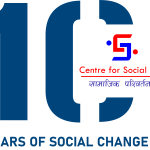
Reflections of the Art-Based Dialogue Workshop
Photo by Rahul Roy
Author: Vicky Mahato
Through many global as well as local examples, it can be said that art-based dialogue is one of innovative ways where students can learn about themselves, their community and issues within their communities. Creation and display of art can generate deeper levels of dialogues on these subjects among youth and student groups.
For instance, a project conducted among Grade 6 students in an English as a Second Language (ESL) program in Toronto, encouraged students to create art that represented their feelings about the world and then share these art pieces among each other. The dialogue process was also supported by an interactive installation of the artwork and a live performance by the artist. This project was created through collaboration with the Toronto District School Board’s Arts Education Department, TDSB Arts Council, and artist-in-residence, Crispin Howlitt.
From this and other similar interventions, it is drawn that dialogue between artists and the community can be an inspiring and special experience for the youth and community members. Some valuable lessons from these experiences are highlighted as follows:
First, art-based dialogues are a great way to inform people about community level issues in an accessible, engaging and personal manner. It is effective for the communities themselves due to an integrated approach of interactivity and participation.
Secondly, the participants of such dialogue program feel welcomed and heard even amid a diverse group of peers by creating a safe space for them talk openly without fear of being judged or attacked. Many times, through art-based dialogues people are invited to share their stories with others even when in the form of an exhibition.
The aim of such dialogue programs is mainly to empower kids with skills required to successfully enter and succeed within school systems. It is an initiative that has seen remarkable outcomes among children who participate, improving their social skills and their confidence. Using both physical art materials and digital tools, one can adopt approaches like art-based dialogue to introduce new concepts, enhance creative thinking and improve social skills to become more confident learners.
Dialogues in current contexts are considered as one of the most essential tools for effective communication. It is a two-way process where people feel heard and understood. Interactive dialogue used in schools is a great form of dialog which provides students with a way to openly express their feelings and share their thoughts. The purpose of such dialogue program is to provide students with meaningful and engaging experiences, but its’ impacts are informative and effective not only for individuals but a at the community levels as well
Discussing the outcomes of an art-based dialogue program conducted in 2017 by Guillermo Villarreal at a school in Guatemala, it can be observed that the program was successful in engaging digital tools in dialogue, that emphasized the importance of creativity and language in digital learning. This intervention sought to explore outcomes of a prototype art-based digital dialogue program.
The design process of this new program was informed by an iterative design-cycle that included user experience testing, device testing, and student surveys. The final result was an immersive dialogue experience where students were able to explore alternate worlds and create stories with a 3D storyboard interface.
To understand the effects of art-based dialogue programs, one often needs to look at the outcomes. The most important thing is to see how students feel after the program. The feedbacks from the digital dialogue program discussed above showed that the strategic dialogues had positive effects on students. Immediately after the program, students were able to visualize and understand the concept that “we are all one”
Innovative programs like such can certainly make a difference in children’s lives and help them to become more open-minded learners. Art-based dialogue programs are expanding its importance among students and teachers as well. It transcends typical classroom discussions and breaks down barriers between people of different cultures, races, gender, etc.
The graphics, views and opinions expressed in the piece above are solely those of the original author(s) and contributor(s). They do not necessarily represent the views of Centre for Social Change.

Vicky Mahato
District Field Officer, Bara
Centre for Social Change
©2021 Centre for Social Change, Kathmandu
